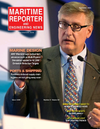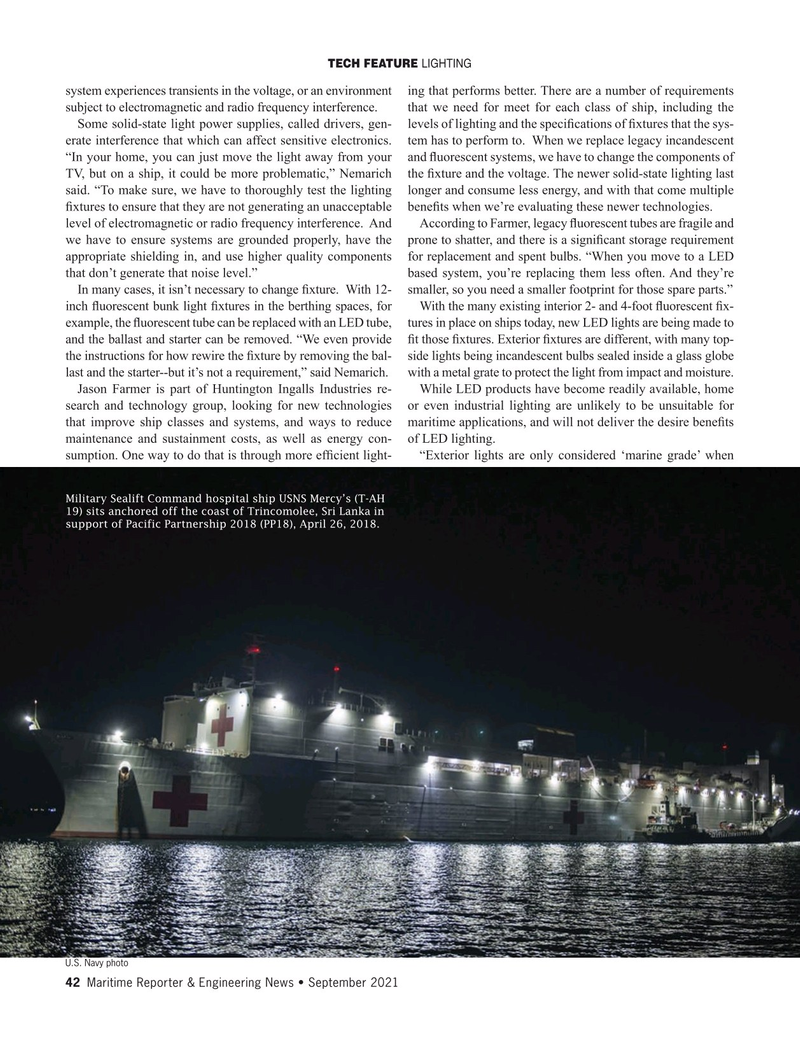
Page 42: of Maritime Reporter Magazine (September 2021)
The Marine Design Edition
Read this page in Pdf, Flash or Html5 edition of September 2021 Maritime Reporter Magazine
TECH FEATURE LIGHTING system experiences transients in the voltage, or an environment ing that performs better. There are a number of requirements subject to electromagnetic and radio frequency interference. that we need for meet for each class of ship, including the
Some solid-state light power supplies, called drivers, gen- levels of lighting and the speci? cations of ? xtures that the sys- erate interference that which can affect sensitive electronics. tem has to perform to. When we replace legacy incandescent “In your home, you can just move the light away from your and ? uorescent systems, we have to change the components of
TV, but on a ship, it could be more problematic,” Nemarich the ? xture and the voltage. The newer solid-state lighting last said. “To make sure, we have to thoroughly test the lighting longer and consume less energy, and with that come multiple ? xtures to ensure that they are not generating an unacceptable bene? ts when we’re evaluating these newer technologies.
level of electromagnetic or radio frequency interference. And According to Farmer, legacy ? uorescent tubes are fragile and we have to ensure systems are grounded properly, have the prone to shatter, and there is a signi? cant storage requirement appropriate shielding in, and use higher quality components for replacement and spent bulbs. “When you move to a LED that don’t generate that noise level.” based system, you’re replacing them less often. And they’re
In many cases, it isn’t necessary to change ? xture. With 12- smaller, so you need a smaller footprint for those spare parts.” inch ? uorescent bunk light ? xtures in the berthing spaces, for With the many existing interior 2- and 4-foot ? uorescent ? x- example, the ? uorescent tube can be replaced with an LED tube, tures in place on ships today, new LED lights are being made to and the ballast and starter can be removed. “We even provide ? t those ? xtures. Exterior ? xtures are different, with many top- the instructions for how rewire the ? xture by removing the bal- side lights being incandescent bulbs sealed inside a glass globe last and the starter--but it’s not a requirement,” said Nemarich. with a metal grate to protect the light from impact and moisture.
Jason Farmer is part of Huntington Ingalls Industries re- While LED products have become readily available, home search and technology group, looking for new technologies or even industrial lighting are unlikely to be unsuitable for that improve ship classes and systems, and ways to reduce maritime applications, and will not deliver the desire bene? ts maintenance and sustainment costs, as well as energy con- of LED lighting. sumption. One way to do that is through more ef? cient light- “Exterior lights are only considered ‘marine grade’ when
Military Sealift Command hospital ship USNS Mercy’s (T-AH 19) sits anchored off the coast of Trincomolee, Sri Lanka in support of Pacific Partnership 2018 (PP18), April 26, 2018.
U.S. Navy photo 42 Maritime Reporter & Engineering News • September 2021
MR #9 (34-49).indd 42 9/7/2021 10:34:57 AM

 41
41

 43
43
